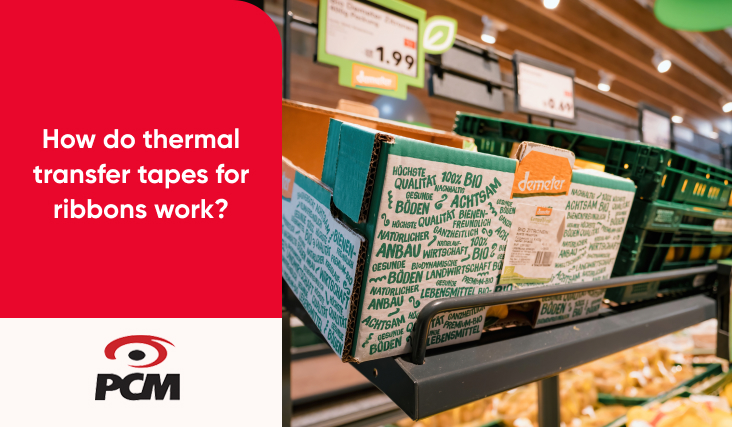- Printed Rolls
- How do thermal transfer tapes for ribbons work?
How do thermal transfer tapes for ribbons work?

The application of heat to the printhead is achieved through thermal transfer tapes for ribbons. This heating action is developed in order to adhere the information to be printed on the body of a given label.
By means of this method, prints are made on various materials except those that are not thermal, that is to say, that do not withstand high temperatures. Sometimes barcodes and also labels are printed in series to make a joint work.
Article content:
Thermal transfer tapes for ribbons: Features
How do thermal transfer ribbons work?
Types of ribbons most commonly used in printers
The experts in ribbons
Thermal transfer tapes for ribbons: Features
The supplies used to print labels are suitable for thermal transfer tapes for ribbons. These supplies come in roll presentations of different sizes that are placed directly on the printer head. They are made of wax substrates, resins, or a fusion between both materials.
It should be noted that the substrates have fundamental characteristics in terms of their malleability, strength, and printing speed, for excellent performance. Their letters and figures cannot be erased by water, extreme heat, strong friction, or exposure to the environment.
Among the most important parts of the ribbons that fulfill different and specific functions, the following can be listed:
Header
It is the external protection that covers the roll. It is used in the installation of the ribbon when it is incorporated into the machine. This covering ensures the care of the implement, preventing the formation of wrinkles or deformations in the ribbon.
Mandrel
It is located in the center of the ribbon, and on it, the different layers that make up the ribbon are wrapped. It has the shape of a cylindrical tube that allows the exact arrangement of the sheets for future printing.
Completion indicator
This is a signal located at the end of the ribbon supply to alert the machine that the material on the roll has run out. It is necessary to indicate that there is not a determined number of layers that wrap around the mandrel although its usefulness is prolonged according to the SUPPLIER of trust.
How do thermal transfer ribbons work?
Thermal transfer is carried out by means of chemical and physical processes in which 3 important factors are involved. These elements are the transferable material, the substrate used in printing and the heat. To understand this process, it is necessary to make certain considerations:
- The transferable material is the ribbon itself also known as thermal transfer ribbon. The referred ribbon is made of polyester and coated by a black pigmentation dissolved in wax or resin depending on the intended use.
- The substrate used is either resin or wax based. In some cases, for high quality reviews, the use of an alloy of both elements is recommended. With this action, greater strength will be achieved to the label prints and their hardness will be better.
- The heat is the main element of this process as it will allow a precise and indelible adhesion on the film. In addition to the high temperature, the pressure exerted by the head on the ribbon is used to achieve a high definition and excellent quality finish.
When referring to the beginning of the operation of thermal transfer tapes for ribbons, it should be noted that first the roll goes to the respective printer. Once installed, it will be arranged against another roll containing the labels to be used, whether they are made of paper, plastic, or fabric.
The performance of the speed, heat and pressure made on the label will make it possible for the necessary information to be easily captured. It should be noted that this process is simple, fast, and extremely economical for companies as logistics costs are significantly reduced.
The work comes to an end when the ribbon runs out and the phrase "end of ribbon" appears. At this moment the machine automatically stops so that the operator can replace the roll. The printing volume is high, and a single ribbon can produce an infinite number of signs.
Types of ribbons most commonly used in printers
Large companies use ribbons according to the technical printing needs they require. For this reason, they search in the market for the options of their preference, ranging from a reasonable price to high-definition prints. The most commonly used types are as follows:
Wax Ribbon
It is the most useful due to its low price. It is recommended for use where labels with high durability and high heat exposure are not required. They are not durable for long periods and are easily erased.
Resin Ribbon
It is used in applications that need a lot of resistance and firmness for special and careful jobs. Its printing does not rub off and can be subjected to high and low temperatures, friction, and contact with chemical products without deformation.
Mixed Ribbon
It is formed by resin and wax compounds that allow a material of great performance, adhesion, and strength. It has a longer and more useful life for labels to last many years without deterioration. Its use is recommended for pharmaceutical products, chemicals, wines, and other alcohols.
The experts in ribbons
PCM is the industry leader in thermal transfer ribbon solutions for ribbons. Its excellent products are designed by professionals with high capacity and under quality, resistance, and durability standards.
At PCM we have more than 26 years of experience in the manufacture and conversion of paper products. Contact our consultants to learn about all the solutions we have available for your business.



 Boxes
Boxes Corrugated
Corrugated Labels
Labels Ribbons
Ribbons Recycler
Recycler Plastics
Plastics